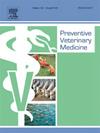埃塞俄比亚博雷纳地区奥罗米亚地区牛、绵羊、山羊和骆驼的布鲁氏菌病血清流行率、特征和危险因素
IF 2.4
2区 农林科学
Q1 VETERINARY SCIENCES
引用次数: 0
摘要
布鲁氏菌病是埃塞俄比亚Borena地区的一个重大问题,由于产奶量减少、流产、不孕和后代虚弱,造成经济损失。然而,该地区对这一问题的报道不足,并得到了充分解决。在2022年11月至2023年6月期间,在埃塞俄比亚Borena区的Gomole和Dhas区进行了一项横断面研究,以估计布鲁氏菌病在牲畜中的血清流行率。该研究包括牛、骆驼、绵羊和山羊,在个体和群体水平上随机抽样。共对490头牛、160头骆驼和330只绵羊和山羊进行了血清阳性率检测。在农民协会内的农场进行随机抽样,在个体和畜群水平上测试牲畜。采集了490头牛、160头骆驼和330头绵羊和山羊的血液样本。用间接酶联免疫吸附试验(iELISA)证实的玫瑰孟加拉试验(RBT)筛选样品。聚合酶链反应(PCR)在血清阳性动物的血凝块样本中检测到布鲁氏菌。山羊的发病率最高,个体和羊群水平的发病率分别为10.0 %和56.7 %。在接触中,牛的感染率最低,个体水平为1.4 %,牛群水平为23.0 %。牛、绵羊和骆驼中均检出abortus和B. melitensis,山羊中以B. melitensis最常见。不同物种间布鲁氏菌病流行率存在统计学上的显著差异,与达斯相比,戈莫莱地区的发病率最高。雌性动物的患病率高于雄性动物,特别是有流产史的动物。Logistic回归分析结果显示,地区和宿主种类与布鲁氏菌感染相关,其中Gomole畜群感染风险较高。绵羊、骆驼和山羊多见布鲁氏菌感染,牛多见流产布鲁氏菌感染,除绵羊外,其余品种均有混合性感染。在奥罗米亚牧区,绵羊、骆驼和山羊多见梅里特布鲁氏菌感染,牛多见流产布鲁氏菌感染,除绵羊外,所有物种均有混合性感染。本文章由计算机程序翻译,如有差异,请以英文原文为准。
Seroprevalence, characterization, and risk factors of brucellosis in cattle, sheep, goats, and camels in the Oromia region, Borena Zone, Ethiopia
Brucellosis is a significant issue in the Borena Zone of Ethiopia, causing economic losses due to decreased milk production, abortions, infertility, and weak offspring. However, it is underreported and adequately addressed in the region. A cross-sectional study was conducted in the Gomole and Dhas districts of the Borena Zone in Ethiopia between November 2022 and June 2023 to estimate the seroprevalence of brucellosis in livestock. The study included cattle, camels, sheep, and goats, with random sampling at the individual and herd levels. A total of 490 cattle, 160 camels, and 330 each of sheep and goats were tested for seroprevalence. Random sampling was done on farms within the peasant association to test livestock at the individual and herd levels. Blood samples were collected from 490 cattle, 160 camels, and 330 each from sheep and goats. Samples were screened with the rose Bengal test (RBT) confirmed with the indirect enzyme-linked immunosorbent assay (iELISA). Polymerase chain reaction (PCR) detected Brucella species in blood clot samples collected from seropositive animals. The highest prevalence was observed in goats, with individual and herd-level rates of 10.0 % and 56.7 %, respectively. In contact, cattle had the lowest prevalence, 1.4 % at the individual level and 23.0 % at the herd level. Both B. abortus and B. melitensis were detected in cattle, sheep, and camels, while B. melitensis was the most common species found in goats. Statistically significant differences in brucellosis prevalence were observed among species, with the highest rates in the Gomole district compared to Dhas. Female animals had a higher prevalence than males, especially those with a history of abortion. Logistic regression showed that district and host species were associated with Brucella infection, with Gomole herds at higher risk. Brucella melitensis infections were common in sheep, camels, and goats, while B. abortus infections were mainly in cattle, with mixed infections in all species except sheep. Brucella melitensis infections were common in sheep, camels, and goats in the Oromia pastoral community, while B. abortus infections were mostly seen in cattle, with mixed infections in all species except sheep.
求助全文
通过发布文献求助,成功后即可免费获取论文全文。
去求助
来源期刊

Preventive veterinary medicine
农林科学-兽医学
CiteScore
5.60
自引率
7.70%
发文量
184
审稿时长
3 months
期刊介绍:
Preventive Veterinary Medicine is one of the leading international resources for scientific reports on animal health programs and preventive veterinary medicine. The journal follows the guidelines for standardizing and strengthening the reporting of biomedical research which are available from the CONSORT, MOOSE, PRISMA, REFLECT, STARD, and STROBE statements. The journal focuses on:
Epidemiology of health events relevant to domestic and wild animals;
Economic impacts of epidemic and endemic animal and zoonotic diseases;
Latest methods and approaches in veterinary epidemiology;
Disease and infection control or eradication measures;
The "One Health" concept and the relationships between veterinary medicine, human health, animal-production systems, and the environment;
Development of new techniques in surveillance systems and diagnosis;
Evaluation and control of diseases in animal populations.
 求助内容:
求助内容: 应助结果提醒方式:
应助结果提醒方式:


